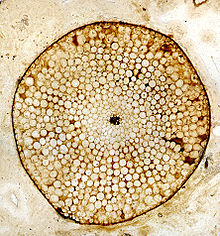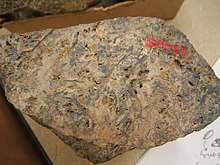Rhynie Chert
As Rhynie Chert is called the fossiliferous cherts (English chert ) from the Lower Devonian (about 396 million years) near the village of Rhynie in the Scottish county of Aberdeenshire . Usually the entire fossil deposit is also called that. He is known for the early land plants Rhynia , Aglaophyton , Horneophyton and Asteroxylon .
Discovery story
In 1912, the physicist and amateur geologist William Mackie (1856–1932) discovered fragments of chert containing plant stems and rhizomes not far from the village of Rhynie . Subsequently, D. Tait, a fossil collector who was in the service of the British Geological Survey , carried out excavations. Using his material, Robert Kidston and WH Lang wrote five papers between 1917 and 1925 in which they described the plants Rhynia , Aglaophyton , Horneophyton and Asteroxylon .
From the 1950s onwards, Geoffrey Lyon of the University of Cardiff , Wales , described fossils from germinating spores. As a result, excavations were carried out again in the 1960s and 1970s. Lyon bought the site and handed it over to the Scottish Natural Heritage in 1982 . Animal remains were also found in the 1920s. These included fairy crabs and springtails . In the 1960s, fan lungs could be detected and thus it could be proven beyond doubt that the trigonotarbids found were land animals. For around 70 years, the Rhynie Chert held the record for the oldest known land animals.
Geology has long been neglected. In 1988, Rice and Trewin recognized that the surrounding silicate rocks are rich in gold and arsenic, that is, come from hot springs. In the 1990s, the fossil-rich Windyfield Chert was discovered around 700 meters away, which had been part of the production channel of a geyser .
geology
The Rhynie Chert and the rocks surrounding it are around 396 ± 8 million years old according to isotope dating. According to today's correlation between geochronology and chronostratigraphy, they are to be placed in the Emsium to the Eifelium . Scotland was then part of the Laurasia continent .
The sediments of the Rhynie Chert were deposited in a narrow basin formed by rocks from the Dalradians and Ordovician . The landscape at that time consisted of rivers and lakes. The rivers have left sloping sands here, and mud has been deposited in other areas. There were hydrothermal springs due to a fault system . The rocks containing chert now form a trough that plunges northeast .
The degree of conservation of the fossils depends on two factors: the degree of decomposition at the time of fossilization and the degree of silicification . In well-preserved specimens, moulting remains ( exuvia ) of arthropods are preserved, the intestinal contents are recognizable or the fan-shaped lungs are preserved down to the finest structures. The hydrothermal springs at Rhynie caused rapid and extensive silicification of the plant and animal material.
Fossils
The best known are probably the vegetable fossils. In many cases they are so well preserved that the cell structures can be examined. In addition to early vascular plants, there are algae , fungi and the oldest known fossil lichens .
Seven of the plants found were real land plants with cuticula , stomata , intercellular spaces, vascular cords with lignin and sporangia . Five of them were real vascular plants with tracheids .
Aglaophyton was not yet a real vascular plant, it lacked the tracheids. Nothia aphylla also had no tracheids and grew on sandy soils and plant litter . Asteroxylon mackiei was a representative of the bear moss plants. Horneophyton lignieri , Rhynia gwynne-vaughanii , Trichopherophyton teuchansii and Ventarura lyonii were real vascular plants thatformed forked, leafless shootsfrom a creeping rhizome . The nematophytes are a little-known, extinct group of plants that may have lived semi-aquatic. Cyanobacteria that formed stromatolites were also found in the Rhynie Chert. Several unicellular and filamentous green algae of the Chlorophyta can be found, as well asrepresentatives similar tothe candelabrum algae such as Palaeonitella .
A number of Rhynie Chert mushrooms have also been described. Among them are the oldest well-preserved specimens of endotrophic mycorrhizae . With Winfrenatia reticulata , the Rhynie Chert is also home to the oldest known lichen. Paleopyrenomycites devonicus , a hose fungus with perithecic fruiting bodies , lived parasitically in the tissue of Asteroxylon and was in turn parasitized by other fungi.
The crabs are represented by Lepidocaris , strongly segmented animals with eleven pairs of leaf-shaped legs. They had long branched antennae and lived aquatic in pools.
On chelicerates there were trigonotarbides , arachnids without venom and spider glands and with a segmented abdomen. They are common in the Rhynie Chert and lived in the countryside. The mites of the Rhynie Chert are the oldest known representatives of this group. The five known species belong to the recent family of the Pachygnathidae . Rhyniella is a member of the Collembola family Isotomidae , which also includes glacier fleas.
Heterocrania rhyniensis is a member of the fossil-only known arthropod group Euthycarcinoidea , which has characteristics of both crustaceans and insects.
The centipedes are represented by Crussolum , a small hunter, and Leverhulmia mariae , in which the intestinal contents were preserved. The species was sediment eater and fed on plant debris.
Paleoecology
The Rhynie Chert is the first known and still the best-researched terrestrial ecosystem . The assumption of some authors that these deposits of hot springs are a highly specialized flora and fauna has since been refuted by finds from other locations. The plants formed a short lawn less than 20 centimeters high in which the first land animals lived.
Holes in plant remains indicate that there were animals, possibly mites, that ate plant sap at the time. Most known animals, however, can be classified as predators because of their mouthparts. There are some sediment eaters, but herbivores are absent. The plant material was decomposed by bacteria and fungi in the soil before it was ingested by the sediment eaters . Herbivores, which can digest plant material with the help of symbiotic bacteria and fungi in the intestine, have only been known since the late Carboniferous .
Other early terrestrial ecosystems
In the 1970s, other similarly old communities were discovered. At Alken on the Moselle, bear moss plants, Rhyniophyta, Trigonotarbiden and Arthropleuriden were discovered together with aquatic animals. At Gilboa ( New York ) 380 million years old plants and animals have been discovered. The land plants and brackish water animals of Ludford Lane ( Shropshire , Great Britain) come from the late Silurian and are currently the oldest known land plants at around 415 million years old.
supporting documents
- Paul Selden , John Nudds: Window on Evolution. Famous fossil sites in the world . Elsevier Spektrum Akademischer Verlag, Munich 2007, pp. 47–50. ISBN 978-3-8274-1771-8
Individual evidence
- ^ History of Research at Rhynie - University of Aberdeen
- ↑ Selden et al. 2007, p. 49
- ↑ The chronostratigraphic age information pragium to early emsium for the Rhynie Chert, which is still given in the most varied of works, is based on an outdated correlation between geochronology and chronostratigraphy (pragium ≈ 396 to 390, emsium ≈ 390 to 386).
- ↑ TN Taylor: Perithecial ascomycetes from the 400 million year old Rhynie chert: an example of ancestral polymorphism . Mycologia, Volume 97 (1), 2005, pp. 269-285.
Web links
- The Rhynie Chert Flora, at www.biologie.uni-hamburg.de
- The Rhynie Chert and its Flora - Paleobotanical Research Group of the University of Münster (English)
- Rhynie cherts, at www.scottishgeology.com (English)
- Rhynie Chert, Scotland (English)
- Full Rhynie Chert page Aberdeen University (English)
Coordinates: 57 ° 20 ′ 12 " N , 2 ° 50 ′ 29" W.



